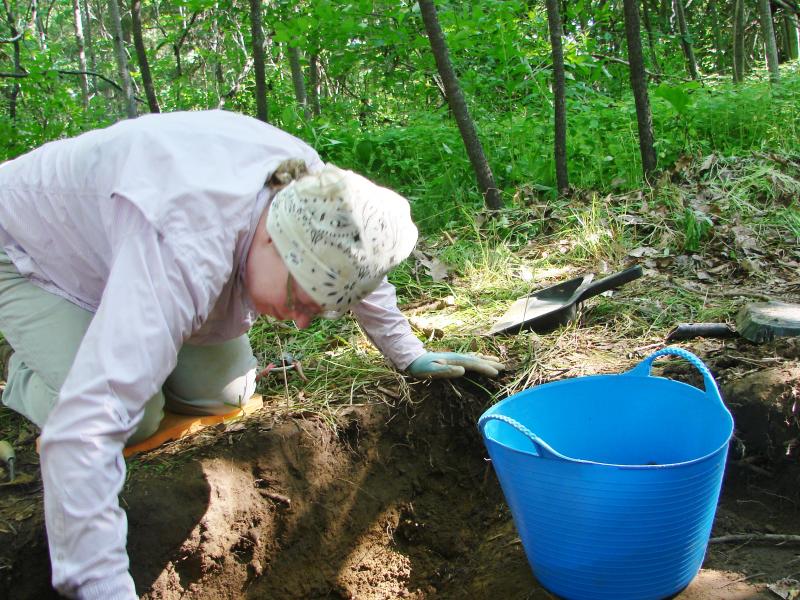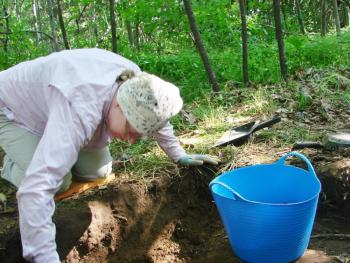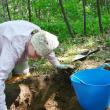Digging for history in Woolwich
 Claire Robinson digs alongside volunteers on her and husband Michael Robinson’s Thwing’s Point, Woolwich property on July 8. The site of the ongoing and earlier archaeological digs was occupied by English settlers three different times in the 1600s and 1700s. SUSAN JOHNS/Wiscasset Newspaper
Claire Robinson digs alongside volunteers on her and husband Michael Robinson’s Thwing’s Point, Woolwich property on July 8. The site of the ongoing and earlier archaeological digs was occupied by English settlers three different times in the 1600s and 1700s. SUSAN JOHNS/Wiscasset Newspaper
 Claire Robinson digs alongside volunteers on her and husband Michael Robinson’s Thwing’s Point, Woolwich property on July 8. The site of the ongoing and earlier archaeological digs was occupied by English settlers three different times in the 1600s and 1700s. SUSAN JOHNS/Wiscasset Newspaper
Claire Robinson digs alongside volunteers on her and husband Michael Robinson’s Thwing’s Point, Woolwich property on July 8. The site of the ongoing and earlier archaeological digs was occupied by English settlers three different times in the 1600s and 1700s. SUSAN JOHNS/Wiscasset Newspaper
The past was coming up in shards and other small pieces in Woolwich on July 8, as Claire and Michael Robinson opened up their Kennebec River property to an archaeological dig.
Tuesday was day two of a two-week dig on the site where three different sets of English settlers lived in the 1600s and 1700s, archaeologist Lee Cranmer said. The first settlement, dating to about 1650, is known for a large meeting the Plymouth Colony organized there to set up a government for the Kennebec region.
In 1989, Cranmer found a 1600s pipe stem along the shoreline. Surveys and digs since then have turned up more evidence of the settlements, including the remains of an ice house, said Cranmer, a retired historic archaeologist for the Maine Historic Preservation Commission.
Among other signs of past settlement is the presence of sumac. The tree often grows where the ground has been disturbed, so a cluster can be worth taking a look at, Cranmer said.
As of Tuesday morning, the latest dig had yet to unearth any major finds, but the small discoveries were numerous, from nails to pieces of porcelain, and glass from a wine bottle. The remains tend to be in shards because the settlers tossed them into their cellars as trash, Cranmer said.
Volunteers including the Robinsons were finding items by digging up the dirt, placing it in plastic tubs for moving, and then sifting it with screens atop wooden frames they would shake.
It was Scott Herring's first dig. Drawn there by his interest in regional history, the Garland man rode a bicycle 120 miles to serve as a volunteer.
Claire Robinson said she and her husband knew when they bought the property from the Nature Conservancy in 2007 that it had some historical significance. That was part of its appeal.
“It's a beautiful spot, but it's also a historic spot,” she said.
“I find it amazing that ... out here in what looks like the middle of the woods that we can actually find things that people used so many hundreds of years ago.”
The Robinsons, along with a foundation for the Moody's bond-rating company Claire Robinson retired from, and Friends of Merrymeeting Bay are sponsoring the dig.
A key aim is to learn more about an apparent pair of cellars, including if they really are two separate ones. So far, it still looked that way. Cranmer said he thinks one of the two 1700s settlements reused the 1600s cellar.
The property sits just miles from another archaeological site regarded as one of Maine's most significant prehistoric sites, located in Dresden. Native Americans had a seasonal campground there, beginning about 9,000 years ago, state officials have said.
Thwing’s Point provided a good vantage point for settlers to see if anyone was traveling the river from either direction, Cranmer said.
Event Date
Address
United States




















